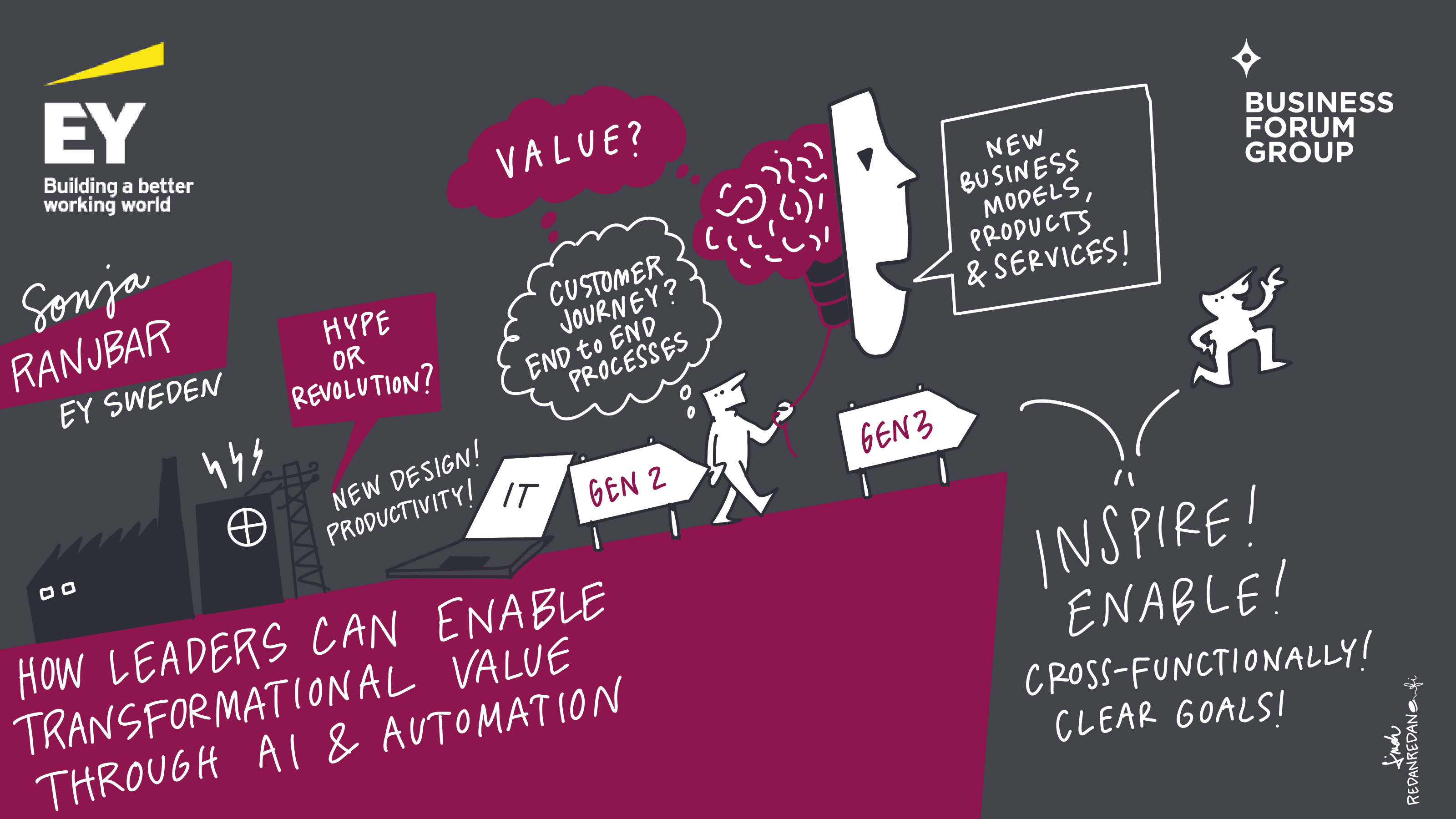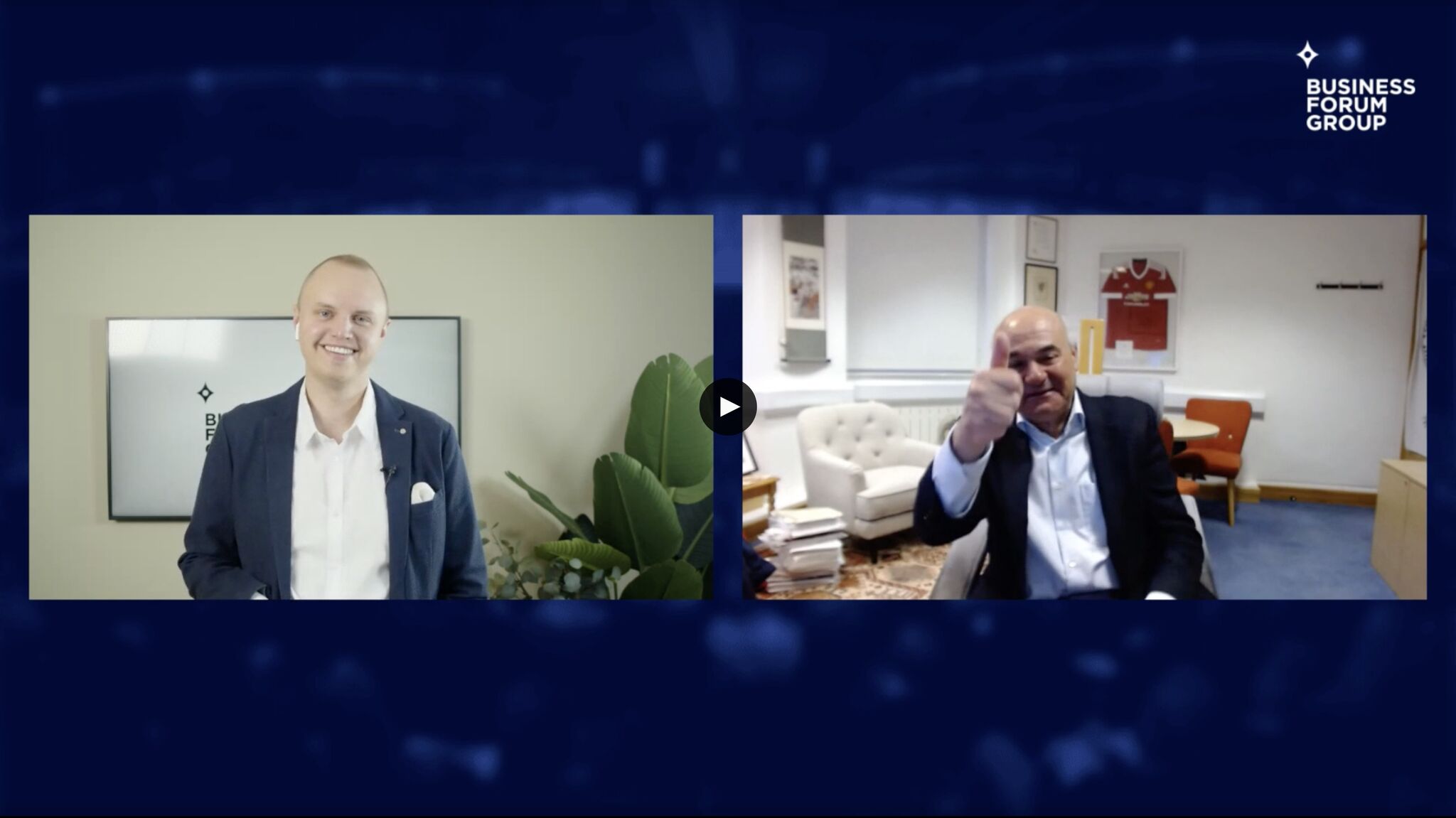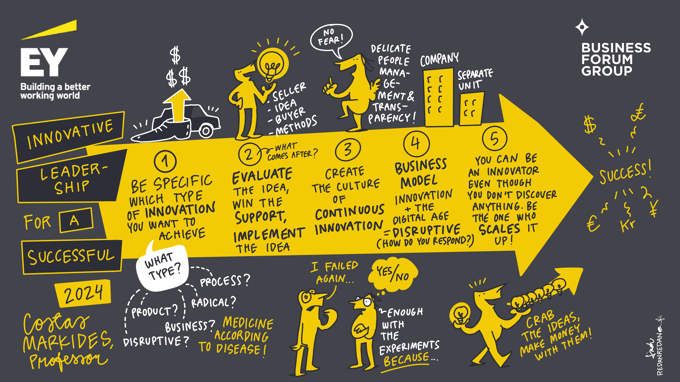In our recent webinar, Costas Markides, professor of Strategy and Innovation at London Business School, teamed up with our partner EY to talk about what leading with innovation will look like in 2024, sharing understandable strategies and ideas for the future.
How Leaders Can Enable Transformational Value through AI & Automation
In the opening session, Sonia Ranjbar, AI and Automation Lead for EY Sweden, shared a blueprint for leaders seeking to enable transformational value in their businesses by leveraging emerging innovations.
Learning how to thrive as a leader means understanding how technologies can be used to accelerate value. But traditionally, it takes time to realize the value innovation can deliver. Consider the advent of things like electricity and information technology. It took nearly 40 years for businesses to adopt electricity in ways that transformed the way we work, and it took 50 years to optimize our use of IT. Now, as leaders consider their use cases for AI and automation, we can expect to see a similar curve.
Work Reimagined
Sonia shared three approaches to AI and automation implementation:
Generation 1: The most common approach to adopting new technologies is tool-led and based on narrow implementation. Leaders may identify a few high-value use cases, but various constraints and dependencies often limit value.
Generation 2: More successful organizations rethink their processes, products, and services when implementing new technologies. They ask, "How can we leverage all these different tools to get better results?" This leads to cross-functional use cases that transform work across silos.
Generation 3: The most successful organizations take a disruptive approach to new technologies. They reimagine what they do and how they do it by defining new business models, products, and services. With this mindset, they free themselves from the constraints of how things work today.
As we enter a new era of innovation, successful leaders will guide their teams to evaluate each situation and determine whether to leverage a first, second, or third generation approach. "It's not either-or," said Sonia. "It's about choosing the right approach in each situation."
 Sonia Ranjbar of EY Sweden: How Leaders Can Enable Transformational Value through AI & Automation.
Sonia Ranjbar of EY Sweden: How Leaders Can Enable Transformational Value through AI & Automation.
Costas Markides: Innovative Leadership for a Successful 2024
Costas Markides is a management educator and professor of strategic leadership at London Business School. He is known for his work on strategic disruption and business models, as illustrated in his book, Game Changing Strategies.
During the webinar, Costas explored ways to cultivate employee engagement and chart a course for the year ahead. He shared five key strategies that illuminate how the most successful leaders inspire and sustain a culture of creativity and innovation.
#1: Be specific about what type of innovation you want to determine what you must do to achieve it.
Leaders commonly ask, "How can I be more innovative?" Costas likens this to going to the doctor when you feel sick and asking what you should do before receiving a diagnosis. It's impossible to give a precise answer to such a broad question.
There are many types of innovation: product, process, business model, strategic, disruptive, and technological. "For each one, we need a different medicine," Costas said.
The steps leaders must take to become more innovative depends on the type of innovation they want to achieve. Costas gave two examples, first pointing to Kiwi shoe polish. Sales of Kiwi were declining, and the company discovered it was attributed to people using furniture polish to clean their shoes because the application was easier and less messy. In response, Kiwi innovated new packaging that resolved consumers' concerns.
Costas contrasted this example with Enterprise, the industry's number one car rental company. Enterprise demonstrated innovation by discovering a new market: people who wanted to rent a car because their vehicle was in the shop for repairs (now known as the Replacement segment). Enterprise built a new business model to serve this segment, and over the next 50 years, it grew into the biggest segment of the car rental market.
"Both are good examples of innovation," Costas said. "But they are examples of what you need to do differently to achieve different types of innovation. Your people cannot deliver until they know exactly what type of innovation you want."

#2: Becoming innovative is less about coming up with ideas and more about what you do after the ideas have been developed.
After leaders have established clarity about the type of innovation they want to achieve, it becomes necessary to determine how to achieve it.
This involves decisions about where to invest resources, how patient to be with those investments, and how to guard against internal politics. More importantly, it involves winning the support of others by selling your ideas. "This is not easy, and often, resistance or lack of support end up killing promising ideas," said Costas.
To demonstrate how difficult gaining support is, Costas asked leaders to consider the many factors that determine whether an idea will gain support. It's important to evaluate who is selling the idea, what it is, who is buying it, and how it's being sold.
"Mistakes happen at each one of these stages, and that's where ideas die," Costas said. "If you don't win the support of your people, innovation is not going to happen."
#3: Creating a culture of innovation requires careful and delicate people management (and this is where the probability of messing up is high).
"We live in a world where the only source of competitive advantage is continuous innovation," said Costas. "Unfortunately, creating a culture of continuous innovation is more difficult than people think."
Experts often say that creating a culture of innovation requires leaders to allow people to:
- Experiment and try new things without fear of failure.
- Question the way you do business all the time.
- Cross silos to work with, share ideas, and collaborate with colleagues in other departments.
- Make decisions and take action without going through procedures and time-consuming approval processes.
- Take personal responsibility for doing something rather than assuming someone else will do it.
"This is all true," Costas said. "But it is very difficult to encourage people to experiment, question things, or take personal responsibility and act."
Developing and maintaining these behaviors in your organization requires leaders to manage people delicately. Costas warned that this is easy to get wrong. He shared the example of experimenting without fear of failure. Is it true all the time and for all employees?
As a leader, you will experience times when you have to say 'yes' to some people and 'no' to others. There will be times when you have to say 'yes' to some experiments and 'no' to others. And there will be times when you forgive some failed experiments and punish others.
"You will need to sometimes encourage the behavior and sometimes discourage the behavior," Costas said. "How easy is that?"
Costas acknowledges that finding the right balance is difficult; he believes it requires delicate people management and continuous communication. He noted this is not the case with only experimentation—leaders must find the right balance of all the behaviors associated with an innovative culture. This includes diversity, autonomy, and cross-functional collaboration.
"Every behavior we want requires very delicate management," Costas said.
#4: Your challenge is to respond rather than discover a new business model.
Costas claims that business model innovation has become the innovation of the digital age. However, for most organizations, the challenge is not to discover a new business model. Rather, it is how to respond to an invading one.
Business model innovation is disruptive to established businesses. As a result, start-up firms are the ones that introduce this type of innovation. "You do not necessarily have to adopt the invading business model," Costas said. "There are other ways to respond to it."
This is where experimentation often comes into play again. Costas encouraged leaders to create separate business units to nurture new business models. He cautioned, however, that this is not sufficient for success.
#5: Position yourself to exploit the discoveries of others. The best innovators are thieves!
Costas wants leaders to understand they can be innovators even if they don't discover anything—because innovation is not the same as invention.
He shared an example from the disposable diaper market. The market was originally discovered in 1932 by a company called Chux, but it was a small, niche market. Almost 40 years later, Proctor & Gamble scaled the product to a mass market with Pampers. P&G has championed this model for decades. In 2003, the company stated: "Our vision is that 50% of all P&G discovery and invention could come from outside the company."
"Many times, one company discovers the product, but it is another company that scales it up," said Costas.
He insists that one way for leaders to become more innovative is to position themselves to take the ideas and discoveries of others and grow them into larger markets. This belief is the basis for his book, Fast Second: How Smart Companies Bypass Radical Innovation to Enter and Dominate New Markets.

Costas Markides: Innovative Leadership for a successful 2024.
Costas summarized his five ideas on innovation in this way:
- The question "How can I become more innovative?" does not make sense!
- The most difficult part of being innovative is what comes after you generate ideas.
- Creating an innovative culture requires careful and delicate management (on a daily and continuous basis).
- Business model innovation is the innovation of the digital age, but your challenge is how to respond to invading business models.
- You can innovate and create huge new markets without discovering anything.
Interested to see what's next after Costas Markides' webinar?
Learn more about Oslo Business Forum 2024: Courageous Leadership 